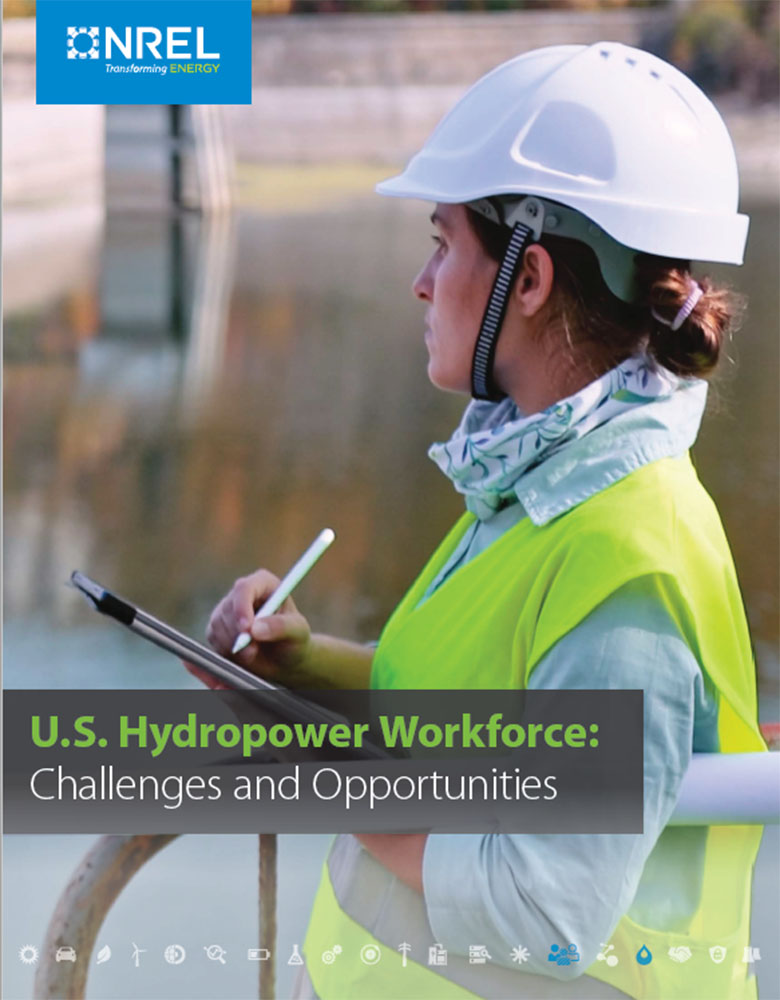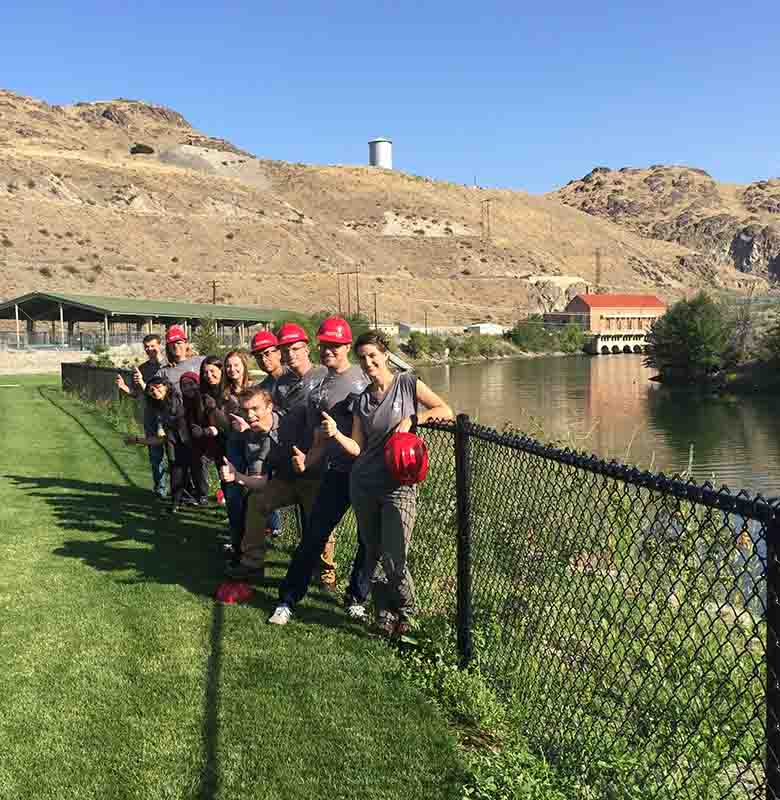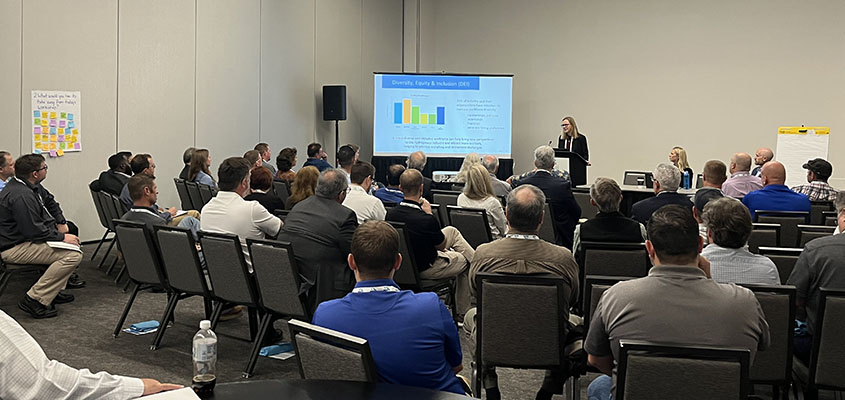Increasing Hydropower Workforce Diversity–And Other Needs To Support Industry Growth
New Study Highlights Hydropower Industry Workforce Trends and Needs
Today’s hydropower workforce is aging, creating an oncoming wave of retirement. Yet, with the development and deployment of new and lower-impact technologies and increased demand for workers, the hydropower industry is projected to grow. In fact, more than a quarter of the domestic hydropower workforce over the age of 55 will retire in the coming decade.
Without a new, diverse workforce, the retirement exodus could impact the hydropower industry’s ability to grow—growth that is critical to helping the country achieve the goal of transitioning to a carbon-free electricity sector by 2035.

The new hydropower workforce report is the result of years of research by NREL, DOE, and others in the hydropower industry. Photo from iStock; cover design by One Tribe Creative, NREL
A new study, U.S. Hydropower Workforce: Challenges and Opportunities, sponsored by the U.S. Department of Energy's (DOE’s) Water Power Technologies Office (WPTO), provides an updated analysis of current hydropower workforce trends based on data collected by the National Renewable Energy Laboratory (NREL), DOE, the Hydropower Foundation, and members of the hydropower industry.
During the four-year project, NREL’s experts engaged with members of the hydropower industry, academics, and students to understand current perspectives about the hydropower sector, career opportunities, and barriers that could hinder workforce growth.
Expanding on NREL’s 2019 Workforce Development for U.S. Hydropower: Key Trends and Findings, this new report includes more detailed data and recommendations about the hydropower workforce. According to the report, major barriers hindering workforce growth include a lack of hydropower educational programs, limited student awareness of the industry, and retirement and recruiting challenges, particularly for jobs in engineering and skilled crafts and trades.
“Many students and potential workers have limited knowledge of the hydropower industry and see it as a solved problem,” said Jennifer Daw, an NREL researcher who helped lead the workforce analysis project. “But hydropower is anything but solved.”
A 100-Year-Old Industry With Untapped Potential
Hydropower may be over a century old, but the industry’s technologies have evolved to meet modern needs. Closed-loop pumped storage hydropower plants can provide much-needed long-term energy storage while protecting local ecosystems. And modern investments in low-impact hydropower, safe fish passage, and power for existing dams are all helping the industry become more sustainable and environmentally friendly.
Hydropower will also play a key role in integrating more renewable energy sources into the grid and nudging the country closer to its aggressive climate goals. But, to fill this critical role, the industry must attract new talent to fill a wide range of jobs across utilities, manufacturing, professional services, construction, and wholesale trade sectors, according to the new report.

Students attended the Hydropower Foundation’s annual Hydro Think Tank Competition in Grand Coulee, Washington, in September 2022. Photo from Bree Mendlin, Hydropower Foundation
“Because hydropower will be an essential source of clean, reliable energy and energy storage in our decarbonized future, we must increase awareness of the need for workers with technical and nontechnical backgrounds in the industry,” Daw said. “As competition for workers grows throughout the energy sector, it’s more critical than ever to strengthen hydropower’s domestic workforce pipeline to meet the industry’s needs both now and in the future.”
According to the report, the hydropower workforce pipeline could be strengthened by providing more relevant work experiences, hydropower coursework, and hands-on learning opportunities for students. Additionally, expanding technical training, apprenticeships, and educational outreach could help the industry overcome challenges with recruiting and the job readiness of new hydropower workers.
“It is clear that more work is required to support the hydropower industry and expand diversity, equity, and inclusion,” said NREL’s Jeremy Stefek, another project lead. “We must educate stakeholders in hydropower’s unique ability to enable a global clean energy transformation.”
The 2022 report includes the following major findings:
- Jobs in skilled crafts and trades and engineering services will be impacted by high retirement and turnover rates in hydropower in the next 5–10 years.
- Demographic data shows a gap in diversity in the U.S. hydropower workforce. The authors found that as of 2022 most workers are men (69%), making up a higher percentage than the average U.S. working population (53%). There is a slightly higher proportion of women in the hydropower workforce (31%) when compared to the energy sector as a whole (25%), but that is lower than the overall U.S. working population (47%). And the share of nonwhite workers in the hydropower industry is 30%, which is higher than the U.S. energy workforce (26%) and general workforce (22%). However, the percentage of white workers has increased 2% since 2019.
- About 73% industry survey respondents indicated they have experienced or observed difficulty hiring women, members of minority groups, tribal members, and veterans. Survey respondents state these challenges are largely due to limited interest from those groups and a low number of applicants.
- Nearly 70% of the U.S. schools surveyed do not offer hydropower degree programs, and more than 60% of U.S. students surveyed indicated they were either unsure if hydropower could be a growing field or did not see hydropower as a growing field.
- More than 77% of surveyed hydropower industry respondents stated that recent graduates have limited knowledge of the hydropower industry, with 23% having no knowledge of it.
Workforce Resources Within Reach
NREL is already working to address several of the challenges indicated by the report. The Water Power STEM to Workforce project is bridging the hydropower workforce gap with partnerships, open-access educational and training resources, tools for job seekers, hands-on collaboration and engagement opportunities, and an intentional approach to diversity and inclusion.
Between 2019 and 2021, the U.S. conventional hydropower industry lost about 3,300 workers, decreasing to about 64,500. With these numbers, the industry represents just 7.5% of workers employed by the U.S. electricity sector, coming in behind other energy industries, including solar power (39%), wind energy (14%), and coal (8.3%).
During the 2022 Clean Currents conference, NREL partnered with the Hydropower Foundation to host a conversation called Advancing the Discussion of Hydropower Workforce Development: Identifying Industry Priorities. The discussion, which engaged almost 70 industry members, was framed around the report findings to help identify urgent hydropower workforce needs as well as potential partnerships for current and future workforce efforts.
The workshop identified three industry priorities, which include:
- Building nationwide partnerships
- Aligning goals with industry to build the pipeline and change perceptions
- Integrating programs at a local, community-based level.
In May 2022, WPTO launched the NREL-administered Hydropower Collegiate Competition to, in part, recruit underrepresented students to the hydropower industry to help increase diversity. The final competition, which aims to help spread awareness and skills to better prepare students for careers in hydropower, will be held in person at Waterpower Week in Washington, D.C., in spring 2023, colocated with the fourth annual Marine Energy Collegiate Competition.

NREL researcher Jennifer Daw (behind the podium) presented the diversity, equity, and inclusion recommendations found in the report at the Clean Currents conference in October 2022. Photo by Betsy Stratton, NREL
Looking to The Future
“Now is the time for educators and industry members to work together,” Stefek said, “to build a stronger, more diverse and inclusive hydropower workforce that will address recruiting and retirement challenges and help the United States achieve its clean energy and climate goals.”

A variety of educational approaches will be needed to bridge the gaps in the hydropower workforce pipeline. Illustration by Alfred Hicks, NREL
Check out the full report to learn more about the challenges facing the U.S. hydropower workforce as well as full reference details, statistics, and more. If you would like to join the virtual follow-on discussion to identify industry priorities and next steps to advancing the hydropower workforce, please contact Jennifer Daw at Jennifer.Daw@nrel.gov.
Interested in expanding your hydropower knowledge? NREL offers free, online resources in the hydropower science, technology, engineering, and mathematics (or STEM) portal. Learn more about NREL's research in hydropower education, and don't forget to sign up for the laboratory's water power newsletter.

